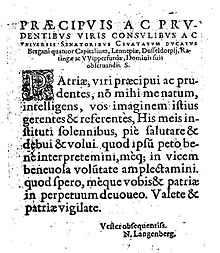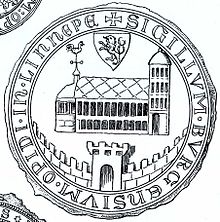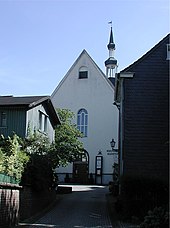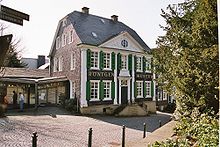Lennep
|
Lennep (3) district of Remscheid |
|||||||||||
|---|---|---|---|---|---|---|---|---|---|---|---|
| Coordinates | 51 ° 11 ′ 33 " N , 7 ° 15 ′ 26" E | ||||||||||
| surface | 27.46 km² | ||||||||||
| Residents | 25,440 (Dec. 31, 2008) | ||||||||||
| Population density | 926 inhabitants / km² | ||||||||||
| Proportion of foreigners | 9.75% (Dec. 31, 2008) | ||||||||||
| Incorporation | Aug 1, 1929 | ||||||||||
| politics | |||||||||||
| Allocation of seats (district representation) | |||||||||||
|
|||||||||||
| Transport links | |||||||||||
| Highway |
|
||||||||||
| Federal road |
|
||||||||||
| Train | S 7 | ||||||||||
| bus | VRS240 VRS336 654 655 664 669 671 NE14 NE16 NE19 | ||||||||||
| Source: statistical data | |||||||||||
With 25,440 inhabitants (as of 2008), Lennep is the second largest urban district of Remscheid . As a member of the Hanseatic League and Prussian district town, Lennep was one of the most important cities in the Bergisches Land for a long time .
Today Lennep still has an old town that is medieval in its basic structure and is one of the 35 selected historic city centers in North Rhine-Westphalia . 116 houses in the city center, including many buildings from the Bergisches Baroque that were built after the city fire of 1746, are listed as historical monuments .
structure
|
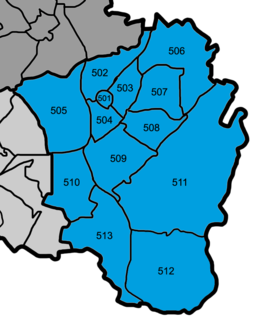
|
history
As evidenced by archaeological finds, human settlements must have existed in the Lennep area as early as 5000 years ago. According to tradition, the city began in the 12th century. In the basin of the stream Linepe (today: Lennepe-Bach) there is said to have been a Fronhof and a chapel dedicated to Saint Nicholas . This Fronhof came into the possession of the Counts of Berg around 1200 and later to the Duke Heinrich von Limburg , who donated it to the St. Kunibert Monastery in Cologne in the first half of the 13th century . With the elevation of the chapel to the parish church, a first closed medieval settlement was formed.
Lennep received from 1259 to 1276 the town charter and is one of the oldest cities of the Bergisch land . In addition to Wipperfürth (1222), Ratingen (1276) and Düsseldorf (1288), Lennep was also one of the four capitals of the Duchy of Berg . In 1276 the town in the Bergisches Land became a court of consultation for the Ratinger court. At that time there was already a high fortification wall with two side gates. Geographically favorable, two day trips from Cologne and Dortmund located on the early medieval long-distance trade route to Magdeburg, Lennep quickly developed into an important trading town. In the 13th century Lennep became a member of the Hanseatic League and had numerous trading establishments. In the course of the 14th century, the Lennep cloth industry, whose products were known far beyond the country's borders, grew stronger. As a result of a city fire around 1325, existing documents were destroyed, so Count Adolf confirmed the city's privileges, which he expanded to include court rights. Since this time at the latest, the city had market and minting rights , and from 1371 also customs law . On September 26, 1563 another fire destroyed the whole city except for a few houses. During the reconstruction, which lasted until 1575 and was supported by tax exemption and privileges by Duke Wilhelm , a structure that was more favorable for the craftsmen was achieved by relocating squares, streets and buildings.
The prosperous development of the city ended with the great city fire on October 4, 1746, to which almost the entire city fell victim. Many craftsmen and merchants then settled in neighboring towns. The baroque reconstruction of the city on the medieval city plan took place slowly. Until industrialization , the city did not grow beyond the medieval wall zone . Only then did the city develop further along the main arterial roads, especially in the south and west, where the Lenneper Neustadt with the district court, train station and district building was created. Nevertheless, the city could hardly compete with the surrounding new large cities in the Wupperviereck . The minutes of the court files from 1696 to 1811 intensively illuminate the internal circumstances of the citizenry.
In 1808, the city became the seat of a canton in the Elberfeld arrondissement of the Rhine department in the Napoleonic Grand Duchy of Kleve and Berg and received a municipal constitution . The local government law of Joachim Murat built 1807 saw first a director, in 1809 a mayor at the head of the community before, supported at less than 5,000 inhabitants of a councilor. They were assisted by municipal councils who were involved in drawing up the budget. In the course of the Congress of Vienna , the area was added to Prussia in 1815 and a mayor's constitution was introduced, according to which a mayor was at the head of the administration.
Lennep was the scene of a cloth workers' strike in 1850 . On August 17, 1857, Lennep was awarded the Prussian town charter. During the First World War and in the course of inflation until 1923 , both the district town and the district issued emergency money .
Until 1929 Lennep was the seat of the Prussian district of the same name . In 1929 it was incorporated into the city of Remscheid . The dissolution of the district and the incorporation initially led to strong protests among the population, but these were in vain. Since then, Lennep has been the largest district of Remscheid in terms of area , which was expanded in 1975 as part of the North Rhine-Westphalian regional reform to include the town of Bergisch-Born , which in part already belongs to Lennep . In 1980 the city's 750th anniversary was celebrated.
coat of arms
The coat of arms of Lennep, which is based on the city seal created in 1260/70 , shows a red city wall with a gate and a red, double-towered church building with a blue roof and blue domes on a silver shield. The (heraldic) right tower is crowned by a golden weathercock. Above the church there is a small silver shield with a red lion rising to the right, the heraldic animal of the younger line of the Counts and Dukes of Berg. The coat of arms of Lennep shows a striking resemblance to the coat of arms of the eight years older city of Wipperfürth: Here, too, a fortified church as a symbol for " city " in direct connection with the sovereign coat of arms testifies to the importance of the place as well as to the prestige gained for the high medieval sovereign associated with a city elevation or city foundation.
City description
The old town of Lennep was built in the Quellmuldental of the Linepe Bach. To this day, the city's ground plan is almost circular. The medieval main trading street Cologne-Magdeburg cuts through the city from south-southwest to northeast and formed a Cologne and a Schwelmer gate in the former city wall. A second street (today Wetterauer Strasse-Alter Markt-Berliner Strasse) relieved the trunk road and leads from the gates to the city's market square. From there you can also access the churchyard with the main church of the city. With the Lüttringhauser Pforte in the northwest and the Mühlenpforte in the east, Lennep had two further entrances to the city, which were connected to the market square by another street (today: Neugasse-Alter Markt-Kronenstrasse-Mühlenstrasse). The medieval fortification ring, which presumably consisted of a wall, rampart and moat, is still followed by Wallstrasse to this day. In the north, various extinguishing and drinking water ponds were connected to Wallstrasse as far as Thüringsberg, but these have now been replaced by a green area.
Little is visible of the original medieval buildings. It burned down almost completely in 1746. Only a few stone components of the town church, especially the tower, date from the early period. Today's development was based on the old plot structure in the second half of the 18th century in the so-called "Bergisch Baroque". This regional style combines baroque forms of jewelry with the local clay frame building. Typical of the Bergisch building tradition are the black paintwork of the stud frame, the white paintwork of the window and door frames, the liming of the compartments , the green paintwork of the shutters and doors and the use of Rhenish slate for wall cladding. Often only the weather side of the building was initially slated; Wealthy builders, however, afforded their houses to be slated on all sides early on. The old town hall (Alter Markt) and the main building of today's Röntgen Museum (patrician house from 1803, Schwelmerstrasse 41) are particularly impressive buildings. The Protestant town church, which was extensively expanded after 1746, also arouses architectural historical interest. The massive medieval tower was given an elegant baroque tower dome, which is still characteristic of the city today. In the interior of the newly built hall church, the principal pieces of altar, pulpit and organ, which are typical of Protestant church buildings in the Bergisches Land, merge into an impressive unit.
Fortunately, the old town of Lennep was almost spared from the Allied bombardment of the Second World War . Only the plastered stone building of the New Town Hall on the Old Market was completely destroyed. In contrast, several high explosive and incendiary bombs hit various buildings in the new town. There was also a major loss of the historical building fabric due to modernization during the economic boom. From the 1970s , the building stock of the 18th century was thoroughly renovated so that the unique urban ensemble has been preserved to this day.
Infrastructure
education
Kindergartens and initiatives
- Kindergarten Westerholt
- Evangelical day care center Albrecht-Thaer-Straße
- Protestant day care center Ringstrasse
- Catholic day care center St Bonaventura
- Parents' initiative KiTa Hackenberg e. V.
- Daycare center Lüttringhauser Straße
- Municipal day care center Henkelshof
- Municipal day care center Bergisch Born
- Waldorf day care center Zaunkönig e. V.
schools
- Catholic Primary School At The Stadium
- Community elementary school Freiherr-vom-Stein
- Community elementary school Hackenberg
- Community elementary school Hasenberg
- Community secondary school Hackenberg
- Albert Schweitzer Secondary School
- Further education college (evening secondary school)
- Röntgen high school, named after Wilhelm Conrad Röntgen, who was born in Lennep .
- Music and art school, Lennep branch
- Special school with the special focus "learning", Pestalozzi
- Rudolf Steiner School Remscheid e. V.
Libraries
- Berliner Strasse district library
traffic
For a long time Lennep was the location of a depot and the most important train station in the Remscheid urban area.
Since the train connections to Radevormwald , to Wermelskirchen / Opladen and to Wipperfürth were discontinued, the station is only served on the Wuppertal-Oberbarmen-Solingen line by the S-Bahn line S7 ( Der Müngstener ) of the S-Bahn Rhein-Ruhr . The three Bergisch small towns of Wermelskirchen , Hückeswagen and Radevormwald are connected to the Remscheid-Lennep train station by several bus routes.
There is a combined cycle and walkway to Bergisch Born on the old railway line , which leads from there to Marienheide and Radevormwald on the one hand, and to Burscheid-Hilgen- Opladen on the other .
Lennep is connected to Autobahn 1 via two junctions .
Culture and sights
Culture
- The Lennep monastery church is the oldest existing religious building in Remscheid. Construction began in 1677 by the Minorites as part of a new monastery and lasted until 1696. They moved into it as early as 1681. During a renovation in the mid-1980s, the original floor window on the north window of the choir apse was exposed. The renovation measures could take place after the association Klosterkirche RS-Lennep e. V. founded, a demolition could be prevented. Today a cultural center and the “Klosterschänke” restaurant are located here. The Klosterkirche cultural center has already brought many great artists to Lennep during the years of its cultural work. Big names like Ingo Appelt, Ralf Schmitz, Bläck Fööss and many more were guests in the old walls of the former monastery.
- The "Rotation Theater" is a private initiative by Reintraut Schmidt-Wien, which converted the rooms of the former rotary printing plant of Bergische Morgenpost / Lenneper Kreisblatt on Kölner Strasse into a spacious room theater. Later she added the "Rotationscafé", where there are also artistic performances.
- The Die Welle youth center is located in the former indoor swimming pool that existed from 1886 to 1979. It has a wide range of offers.
Churches
- Evangelical town church
- Catholic parish church of St. Bonaventure
- Forest church of the Protestant parish Lennep
- Free evangelical community
- Catholic parish church St. Andreas in Bergisch Born
- Evangelical Church in Bergisch Born
- Evangelical Church in Kräwinklerbrücke
Museums
Attractions
- Historic old town with Wallstrasse, Bocksgasse, Botengasse, Pilgergasse, Alter Markt, Greuelgasse and Kraspütt
- Garden house in Hardtpark
- Wuppertalsperre , tank dam
- Hardtpark, on both sides of Wupperstrasse
- Former registry office
- Former bunker from the Second World War, near Kraspütt
- Former agricultural school on Röntgenstrasse
- Röntgen's birthplace
- Old district court
- Former district house
- Former "Bergisches Alumnat ", built in 1908 in Hackenberger Strasse near Teichstrasse, where students from the Lennep Hardtstrasse high school and later the Röntgen School were accommodated. The first Lenneper alumnate was in today's Bahnhofstrasse.
Botengasse in the old town of Lennep
Greuelgasse in the old town of Lennep
Former "Bergisches Alumnat " in Hackenberger Strasse
newspaper
- Lennep im Blick , newspaper of the Heimatbund Lüttringhausen e. V. since 1931, office at Gertenbachstrasse 20, appears on Thursdays and has a circulation of around 12,800 copies, in combination with Lüttringhauser Anzeiger 22,500 copies.
Clubs and organizations
- Anna Hardt Foundation e. V.
- YMCA Lennep e. V.
- The wave e. V.
- Evangelical parish of Lennep
- Lennep Fire Brigade Association V.
- Lennep volunteer fire department
- Volunteer Fire Brigade Zug Bergisch Born
- Volunteer fire brigade Zug Lüdorf
- IG Bergisch Born e. V.
- IG Hasenberg e. V.
- Carnival Association "Blue-White Boys"
- Lennep Ost allotment gardening association
- Lenneper Garden Friends allotment garden association
- Allotment garden association Kimmenau
- Allotment garden association Trecknase
- Small animal breeding association R 248 RS
- Lennep Offensive e. V.
- Lenneper Altstadtfreunde e. V.
- Lenneper Postage Stamp Friends
- Lenneper Carnival Society e. V.
- Lenneper Schützenverein 1805 e. V.
- Lenneper Swimming Club 1898 e. V.
- Lenneper Turngemeinde 1860 e. V.
- Lions Club Lennep
- Louise Hardt Foundation V.
- MG Stammtisch Bergisch Land
- MGV "Glocke" Hackenberg e. V.
- Roller sports club IGR Remscheid e. V.
- Lennep Rotary Club
- Chess friends Lennep
- Chess Club SF Lennep e. V.
- Shooting club SSV Lennep
- School association of the Albert Schweitzer School
- School Association Hackenberg
- School association KGG at the stadium
- Pestalozzi School Association
- School association Röntgen-Gymnasium
- Schützenverein Eintracht Lennep 1928 e. V.
- SG Lennep Altstadt e. V.
- Tefental settlement community
- Sports club SG Hackenberg 1973 e. V.
- SSV Bergisch Born
- TC FA Lennep
- Tennis club Grün-Weiß Lennep e. V.
- Animal Welfare Association
- Gymnastics Club Frisch-Auf Lennep 1933 e. V.
- Lennep Monastery Church Association V.
- Verkehrs- und Förderverein Lennep e. V.
- VfL 1907 Lennep e.V. V.
- Waldorf School
Personalities
Mayor of Lennep
For the years 1413–1806, that is, for the time when Lennep was the first "capital" in rank in the Duchy of Berg , see the list of mayors of Lennep 1413–1806 .
- 1808–1824: Franz Hasselkus
- 1825–1832: Peter Carl Moll
- 1832–1845: Carl Wille
- 1846–1872: Rudolf Trip
- 1872–1897: Ferdinand Sauerbronn
- 1897–1921: Rudolf Stosberg
- 1921–1929: Emil Nohl
District Mayor:
- 1999–2014 Dr. Heinz-Dieter Rohrweck
- since 2014 Markus Kötter
Sons and daughters of the place
- Adolf Clarenbach (≈1497–1529), Latin school teacher, spokesman for the Reformation in the Bergisches Land, in the Münsterland and on the Lower Rhine
- Peter Tuckermann (1580–1651), Lutheran theologian
- Johann Daniel Fuhrmann (1810–1885), Privy Councilor and District Administrator
- Friedrich Arnold Herring (1812–1908), textile manufacturer, evangelist and dissident
- Wilhelm Girardet (1838–1918), publisher
- Wilhelm Conrad Röntgen (1845–1923), physicist, discoverer of X-rays
- Wilhelm Friedrich Laur (1858–1934), architect, state curator for Hohenzollern
- Johann Christian Josef Ommerborn (1863–1938), journalist, writer, head of the "Landstrasse Mission"
- Wilhelm Keller (1866–1941), Austrian-Bohemian industrialist and politician
- Oscar Schlitter (1868–1939), banker and chairman of the supervisory board of Deutsche Bank AG
- Martha von Laffert (born July 4, 1883 in Lennep; † June 11, 1966 in Leutesdorf ), painter
- Fritz Windgassen (1883–1963), opera singer (tenor)
- Elisabeth Dicke born Amann (1884–1952), physiotherapist, developer of connective tissue massage
- Otto Eichhorn (1884–1966), district administrator in Waldbröl and Verden
- Curt Corrinth (1894–1960), poet, novelist, playwright and screenwriter
- Siegfried Reitz (1910–1999), architect and urban planner
- Adolf Müller (1916–2005), trade unionist and politician (CDU), Member of the Bundestag
- Michael Watzke (1973) radio journalist, screenwriter and director
- Klaus Winterhager (1929–2016), graphic designer and communication designer
- Stefan F. Winter (1960–2018), doctor, university professor, manager and State Secretary
- Jonas Dassler (* 1996), actor
Honorary citizen
- 1890: Richard von Hardt , wholesale merchant and manor owner, (born August 6, 1824 in Lennep, † September 29, 1898 in Berlin), numerous foundations, mainly for social purposes, honorary citizen of Lennep since December 2, 1890.
- 1895: Prince Otto von Bismarck , Chancellor 1871–1890, (* April 1, 1815 Schönhausen, † July 30, 1898 Friedrichsruh), honorary citizen of Remscheid, Lenneps and Lüttringhausen since 1895 (on his 80th birthday)
- 1896: Wilhelm Conrad Röntgen , Professor of Physics in Gießen, Würzburg and Munich, (* March 27, 1845 Lennep, † February 10, 1923 Munich), discoverer of the X-rays named after him, 1st Nobel Prize Winner for Physics 1901, 1923 - Studienwerk Foundation (Lennep), inauguration of the Roentgen Memorial in Lennep in 1930, opening of the Roentgen Museum in Lennep in 1932, honorary citizen of Lenneps since June 15, 1896.
- 1900: Richard Koenigs , Upper Government Councilor, (* March 28, 1853 Dülken, † February 14, 1921 Düsseldorf), District Administrator of the Lennep District 1882–1899, special merit in agriculture and industry, 1899 to 1916 Upper Government Councilor in Düsseldorf, honorary citizen of all cities and Rural communities in the Lennep district since 1900.
- 1910: Johann Daniel Fuhrmann , wholesale merchant, (* October 21, 1839 in Lennep, † January 17, 1911 in Antwerp), numerous donations and foundations a. a. 1911 Foundation for the Welfare of Poor Children, Lennep's honorary citizenship since December 13, 1910.
- 1929: Julius Caesar , factory owner, (born January 3, 1887 Elberfeld, † missing), Wilhelmstal paper factory, 1919–1929 1st alderman in Lennep, honorary citizen of Lenneps since July 26, 1929.
- 1929: Hermann Hardt , councilor (since 1906) and cloth manufacturer, (* May 24th, 1866 in Lennep, † December 10th, 1938 in Lennep), senior manager of Joh.Wülfing & Sohn. Was a city councilor a. Chairman of the non-profit building association. Promoted social and cultural endeavors of various kinds, Lennep's honorary citizen since July 26, 1929.
People who worked in Lennep
- Johannes Scheibler (1628–1689), senior pastor in Lennep and general superintendent of the Jülich-Berg Lutheran congregations in Jülich and Berg.
Lennep in the USA
Lennep is a small town in Meagher County in the US state of Montana . The Lennep Trinity Lutheran Church is also in the ghost town . The dark brown "Lennep Sandstone" occurs in the region.
References
literature
- Carl vom Berg, history of the former Bergisch capital Lennepe, document book, vol. 1, Lennepe 1900
- E [rnst] Erwin Stursberg : On the older story of Lennep. (Contributions to the history of Remscheid, 7). Remscheid 1956, DNB 454955537 .
- E [rnst] Erwin Stursberg: Remscheid and its communities. History, economy, culture. Remscheid 1969, DNB 740655051 .
- Dieter Dowe : The labor dispute in the cloth factories of the Lennep district (Bergisches Land) 1850. In: Klaus Tenfelde, Heinrich Volkmann (Hrsg.): Strike. On the history of the labor dispute in Germany during industrialization. Beck, Munich 1981, ISBN 3-406-08130-4 , pp. 31-51.
- Sven Neufert, Florian Neuhann: Hands off Lennep. Lennep's struggle for independence 1929. RGA Buchverlag, Remscheid 2003, ISBN 3-923495-67-6 .
- Johannes Kessler: The monastery church in Lennep. Church-Commerce-Culture. RGA Buchverlag, Remscheid 2008, ISBN 978-3-940491-02-2 .
- Hans-Jürgen Roth: History of our city. Remscheid with Lennep and Lüttringhausen . RGA-Buchverlag, Remscheid 2008, ISBN 978-3-940491-01-5 .
- NJ Breidenbach: The court in Lennep - Received minutes from 1696 to 1811. Bergischer Verlag, Remscheid 2016, ISBN 978-3-945763-28-5 .
swell
- ↑ nrw.de: Historic city centers and town centers in North Rhine-Westphalia ( Memento of the original from October 30, 2015 in the Internet Archive ) Info: The archive link was inserted automatically and has not yet been checked. Please check the original and archive link according to the instructions and then remove this notice.
- ↑ Dedication of the dissertation of Dr. jur. Nikolaus von Langenberg from Wipperfürth, Würzburg 1596.
- ^ A b Toni Diederich , Rheinische Städtesiegel (Rhein. Association for Monument Preservation and Landscape Protection , Jb. 1984/85), Neuss 1984, p. 281.
- ^ A b c Hans-Jürgen Roth: History of our city. Remscheid with Lennep and Lüttringhausen . RGA-Buchverlag, Remscheid 2008, ISBN 978-3-940491-01-5 , p. 269 .
- ^ Hans-Jürgen Roth: History of our city. Remscheid with Lennep and Lüttringhausen . RGA-Buchverlag, Remscheid 2008, ISBN 978-3-940491-01-5 , p. 55 .
- ↑ baukunst-nrw.de: Lennep district building (today the Pestalozzi School)
- ^ Entry on Lennep in the statistics of the government district of Düsseldorf , by Otto von Mülmann , Baedeker, Iserlohn, 1864, pp. 434–435, online at books.google.de, viewed March 14, 2010.
- ↑ Various coins and notes from Lennep between 1917 and 1923 on the private website lennep.eu
- ↑ see literature
- ↑ Article of the Bergische Zeitgeschichte e. V. on the lecture by Sven Neufert and Florian Neuhann: Hands off Lennep (on the destruction of the Lennep district in 1929)
- ↑ Statistical yearbook 2008 of the city of Remscheid , online on the website of the city of Remscheid (PDF), ISSN 0930-2034 , p. 19.
- ↑ Detailed description in: Toni Diederich , Rheinische Städtesiegel (Rhein. Association for Monument Preservation and Landscape Protection , Jb. 1984/85), Neuss 1984, pp. 280–282; Original seal ibid. Fig. 67.
- ↑ Lennep city coat of arms ( memento from March 1, 2014 in the Internet Archive ) on ngw.nl
- ^ History and founding of the monastery on the website of the monastery church Lennep, as seen on December 20, 2015
- ^ Bergische Morgenpost: The ruined monastery became a gem , March 26, 2005.
- ↑ Isabel Klaas: Heavenly living , Bergische Morgenpost, March 15, 2006.
- ↑ lalib.de
- ↑ Dr. Heinz-Dieter Rohrweck ( Memento from June 25, 2014 in the Internet Archive ) on the website of the city of Remscheid
- ↑ US Geological Survey: Lennep Sandstone , accessed January 27, 2017



